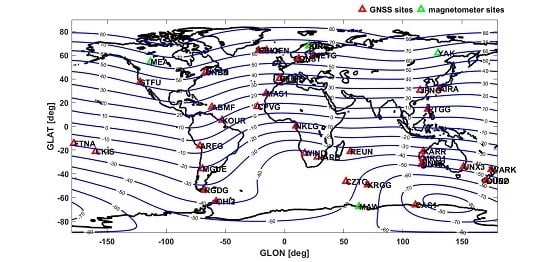Studying Ionosphere Responses to a Geomagnetic Storm in June 2015 with Multi-Constellation Observations
Abstract
:1. Introduction
2. Data Presentation
2.1. Calculation of the TEC and ROTI
- Extraction of the un-calibrated slants from GNSS observations
- Quality control of the GNSS observations, elevation mask, arcs discontinuities, recovery of cycle slips, and so forth.
- Solve Equation (7) with the least-squares solution indicated by summation of Equation (6)
- Calculating the residuals of the solution
2.2. Calculation of Geomagnetic Perturbations
2.3. Calculation of the Ionosphere Gradient
- The TEC calculation using raw GNSS carrier phase measurements, as Section 2.1 described.
- The TEC slips detection method of Astfayeva is implemented [38]; TEC slips are calculated by the difference of two adjacent epochs of calibrated slant TEC values; epochs with intervals of 30 s.
- Removing the TEC slips larger than the threshold for ionosphere gradient calculation; the threshold is set to be 2 TECU in the middle latitudes, 3TECU in the low latitudes and equatorials (refer to Reference [38]).
- Calculating the ionosphere gradient with Equation (13).
- The post-processing check for large gradient values, to exclude the gradients strongly influenced by cycle slips.
3. Results
3.1. Global Morphology of Geomagnetic Storms
3.2. Global TEC Responses
3.3. Local TEC Responses from MGEX Observations
3.4. Local ROTI Variations
3.5. The Effect on the Ionosphere Spatial Gradient
4. Discussion
4.1. TEC Responses to the Geomagnetic Storm
4.2. Irregularities Generated by the Geomagnetic Storm
4.3. Benefits from Multi-GNSS Observations
4.4. Cause of Large Ionosphere Spatial Gradients
5. Conclusions
Author Contributions
Acknowledgments
Conflicts of Interest
References
- Zaourar, N.; Amory-Mazaudier, C.; Fleury, R. Hemispheric asymmetries in the ionosphere response observed during the high-speed solar wind streams of the 24–28 August 2010. Adv. Space Res. 2017, 59, 2229–2247. [Google Scholar] [CrossRef]
- Prikryl, P.; Ghoddousi-Fard, R.; Thomas, E.G.; Ruohoniemi, J.M.; Shepherd, S.G.; Jayachandran, P.T.; Danskin, D.W.; Spanswick, E.; Zhang, Y.; Jiao, Y.; et al. GPS phase scintillation at high latitudes during geomagnetic storms of 7–17 March 2012—Part 1: The North American sector. Ann. Geophys. 2015, 33, 637–656. [Google Scholar] [CrossRef]
- Nava, B.; Rodríguez-Zuluaga, J.; Alazo-Cuartas, K.; Kashcheyev, A.; Migoya-Orué, Y.; Radicella, S.M.; Amory-Mazaudier, C.; Fleury, R. Middle- and low-latitude ionosphere response to 2015 St. Patrick’s Day geomagnetic storm. J. Geophys. Res. Space Phys. 2016, 121, 3421–3438. [Google Scholar] [CrossRef]
- Jin, S.; Jin, R.; Kutoglu, H. Positive and negative ionospheric responses to the March 2015 geomagnetic storm from BDS observations. J. Geod. 2017, 91, 1–14. [Google Scholar] [CrossRef]
- Azzouzi, I.; Migoya-Orue, Y.; Mazaudier, C.A.; Fleury, R.; Radicella, S.M.; Touzani, A. Signatures of solar event at middle and low latitudes in the Europe-African sector, during geomagnetic storms, October 2013. Adv. Space Res. 2015, 56, 2040–2055. [Google Scholar] [CrossRef] [Green Version]
- Mao, T.; Sun, L.; Hu, L.; Wang, Y.; Wang, Z. A case study of ionospheric storm effects in the Chinese sector during the October 2013 geomagnetic storm. Adv. Space Res. 2015, 56, 2030–2039. [Google Scholar] [CrossRef]
- Aarons, J.; Whitney, H.E.; Allen, R.S. Global morphology of ionospheric scintillations. Proc. IEEE 1982, 59, 159–172. [Google Scholar] [CrossRef]
- Forte, B.; Radicella, S.M.; Ezquer, R.G. A different approach to the analysis of GPS scintillation data. Ann. Geophys. 2002, 45, 551–561. [Google Scholar]
- Li, G.; Ning, B.; Zhao, B.; Liu, L.; Wan, W.; Ding, F.; Xu, J.S.; Liu, J.Y.; Yumoto, K. characterizing the 10 November 2004 storm-time middle-latitude plasma bubble event in Southeast Asia using multi-instrument observations. J. Geophys. Res. Space Phys. 2009, 114, 1–16. [Google Scholar] [CrossRef]
- Cherniak, I.; Zakharenkova, I. First observations of super plasma bubbles in Europe. Geophys. Res. Lett. 2016, 43, 11137–11145. [Google Scholar] [CrossRef]
- Carter, B.A.; Yizengaw, E.; Pradipta, R.; Retterer, J.M.; Groves, K.; Valladares, C.; Caton, R.; Bridgwood, C.; Norman, R.; Zhang, K. Global equatorial plasma bubble occurrence during the 2015 St. Patrick’s Day storm. J. Geophys. Res. Space Phys. 2016, 121, 894–905. [Google Scholar] [CrossRef]
- Ray, S.; Roy, B.; Das, A. Occurrence of equatorial spread F during intense geomagnetic storms. Radio Sci. 2015, 50, 563–573. [Google Scholar] [CrossRef]
- Rovira-Garcia, A.; Juan, J.M.; Sanz, J.; González-Casado, G.; Ibáñez, D. Accuracy of ionospheric models used in GNSS and SBAS: Methodology and analysis. J. Geod. 2016, 90, 229–240. [Google Scholar] [CrossRef]
- Bang, E.; Lee, J. Methodology of automated ionosphere front velocity estimation for ground-based augmentation of GNSS. Radio Sci. 2013, 48, 659–670. [Google Scholar] [CrossRef]
- Zhao, L.; Yang, F.; Li, L.; Ding, J.; Zhao, Y. GBAS Ionospheric Anomaly Monitoring Based on a Two-Step Approach. Sensors 2016, 16, 763. [Google Scholar] [CrossRef] [PubMed]
- Park, Y.S.; Zhang, G.; Pullen, S.; Lee, J.; Enge, P. Data-replay analysis of LAAS safety during ionosphere storms. Proc. ION GNSS 2007, 2007, 25–28. [Google Scholar]
- Saito, S.; Yoshihara, T. Evaluation of extreme ionospheric Total Electron Content (TEC) gradient associated with plasma bubbles for GNSS Ground-based Augmentation System (GBAS). Radio Sci. 2017, 52, 951–962. [Google Scholar] [CrossRef]
- Nykiel, G.; Zanimonskiy, Y.M.; Yampolski, Y.M.; Figurski, M. Efficient Usage of Dense GNSS Networks in Central Europe for the Visualization and Investigation of Ionospheric TEC Variations. Sensors 2017, 17, 2298. [Google Scholar] [CrossRef] [PubMed]
- Pi, X.; Mannucci, A.J.; Lindqwister, U.J.; Ho, C.M. Monitoring of global ionospheric irregularities using the Worldwide GPS Network. Geophys. Res. Lett. 1997, 24, 2283–2286. [Google Scholar] [CrossRef]
- Gao, Z.; Shen, W.; Zhang, H.; Niu, X.; Ge, M. Real-time Kinematic Positioning of INS Tightly Aided Multi-GNSS Ionospheric Constrained PPP. Sci. Rep. 2016, 6, 30488. [Google Scholar] [CrossRef] [PubMed]
- Ren, X.; Zhang, X.; Xie, W.; Zhang, K.; Yuan, Y.; Li, X. Global Ionospheric Modelling using Multi-GNSS: BeiDou, Galileo, GLONASS and GPS. Sci. Rep. 2016, 6, 33499. [Google Scholar] [CrossRef] [PubMed]
- Dow, J.M.; Neilan, R.E.; Rizos, C. The International GNSS Service in a changing landscape of Global Navigation Satellite Systems. J. Geod. 2009, 83, 191–198. [Google Scholar] [CrossRef]
- Guo, F.; Li, X.; Zhang, X.; Wang, J. The contribution of Multi-GNSS Experiment (MGEX) to precise point positioning. Adv. Space Res. 2016, 59, 2714–2725. [Google Scholar] [CrossRef]
- Gao, W.; Gao, C.; Pan, S.; Meng, X.; Xia, Y. Inter-System Differencing between GPS and BDS for Medium-Baseline RTK Positioning. Remote Sens. 2017, 9, 948. [Google Scholar] [CrossRef]
- Astafyeva, E.; Zakharenkova, I.; Alken, P. Prompt penetration electric fields and the extreme topside ionospheric response to the June 22–23, 2015 geomagnetic storm as seen by the Swarm constellation. Earth Planets Space 2017, 68, 152. [Google Scholar] [CrossRef]
- Reiff, P.H.; Daou, A.G.; Sazykin, S.Y.; Nakamura, R.; Hairston, M.R.; Coffey, V.; Chandler, M.O.; Anderson, B.J.; Russell, C.T.; Welling, D.; et al. Multispacecraft Observations and Modeling of the June 22/23, 2015 Geomagnetic Storm. Geophys. Res. Lett. 2016, 43, 7311–7318. [Google Scholar] [CrossRef]
- Montenbruck, O.; Steigenberger, P.; Prange, L.; Deng, Z.; Zhao, Q.; Perosanz, F.; Romero, I.; Noll, C.; Stürze, A.; Weber, G.; Schmid, R. The Multi-GNSS Experiment (MGEX) of the International GNSS Service (IGS)—Achievements, prospects and challenges. Adv. Space Res. 2017, 59, 1671–1697. [Google Scholar] [CrossRef]
- Davis, T.N.; Sugiura, M. Auroral electrojet activity index AE, and its universal time variations. J. Geophys. Res. Space Phys. 1966, 71, 785–801. [Google Scholar] [CrossRef]
- Ciraolo, L.; Azpilicueta, F.; Brunini, C.; Meza, A.; Radicella, S.M. Calibration errors on experimental slant total electron content (TEC) determined with GPS. J. Geod. 2007, 81, 111–120. [Google Scholar] [CrossRef]
- Cherniak, I.; Zakharenkova, I.; Krankowski, A. Approaches for modeling ionosphere irregularities based on the TEC rate index. Earth Planets Space 2014, 66, 165. [Google Scholar] [CrossRef]
- Sieradzki, R.; Paziewski, J. Study on reliable GNSS positioning with intense TEC fluctuations at high latitudes. GPS Solut. 2016, 20, 553–563. [Google Scholar] [CrossRef]
- Liu, K.; Li, G.; Ning, B.; Hu, L.; Li, H. Statistical characteristics of low-latitude ionospheric scintillation over China. Adv. Space Res. 2015, 55, 1356–1365. [Google Scholar] [CrossRef]
- Akala, A.O.; Doherty, P.H.; Carrano, C.S.; Valladares, C.E.; Groves, K.M. Impacts of ionospheric scintillations on GPS receivers intended for equatorial aviation applications. Radio Sci. 2012, 47, 1–11. [Google Scholar] [CrossRef]
- Seo, J.; Lee, J.; Pullen, S.; Enge, P.; Close, S. Targeted Parameter Inflation within Ground-Based Augmentation Systems to Minimize Anomalous Ionospheric Impact. J. Aircr. 2015, 49, 587–599. [Google Scholar] [CrossRef]
- Datta-Barua, S.; Lee, J.; Pullen, S.; Luo, M.; Ene, A.; Qiu, D.; Zhang, G.; Enge, P. Ionospheric Threat Parameterization for Local Area Global-Positioning-System-Based Aircraft Landing Systems. J. Aircr. 2010, 47, 1141–1151. [Google Scholar] [CrossRef]
- Lee, J.; Moonseok, Y.; Pullen, S.; Gillespie, J.; Mathur, N.; Cole, R.; Rodriguez de Souza, J.; Doherty, P.; Pradipta, R. Preliminary results from ionospheric threat model development to support GBAS operations in the Brazilian region. In Proceedings of the 28th International Technical Meeting of the ION Satellite Division, ION GNSS+ 2015, Tampa, Florida, 14–18 September 2015; pp. 1500–1506. [Google Scholar]
- Rungraengwajiake, S.; Supnithi, P.; Saito, S.; Siansawasdi, N.; Saekow, A. Ionospheric delay gradient monitoring for GBAS by GPS stations near Suvarnabhumi airport, Thailand. Radio Sci. 2015, 50, 1076–1085. [Google Scholar] [CrossRef]
- Astafyeva, E.; Yasyukevich, Y.; Maksikov, A.; Zhivetiev, I. Geomagnetic storms, super-storms and their impacts on GPS-based navigation systems. Space Weather Int. J. Res. Appl. 2014, 12, 508–525. [Google Scholar] [CrossRef]
- Astafyeva, E.; Zakharenkova, I.; Förster, M. Ionospheric response to the 2015 St. Patrick’s Day storm: A global multi-instrumental overview. J. Geophys. Res. Space Phys. 2015, 120, 9023–9037. [Google Scholar] [CrossRef]
- Komjathy, A.; Sparks, L.; Wilson, B.D.; Mannucci, A.J. Automated daily processing of more than 1000 ground-based GPS receivers for studying intense ionospheric storms. Radio Sci. 2016, 40, 1–11. [Google Scholar] [CrossRef]
- Roma-Dollase, D.; Hernández-Pajares, M.; Krankowski, A.; Kotulak, K.; Ghoddousi-Fard, R.; Yuan, Y.; Li, Z.; Zhang, H.; Shi, C.; Wang, C.; et al. Consistency of seven different GNSS global ionospheric mapping techniques during one solar cycle. J. Geod. 2017. [Google Scholar] [CrossRef]
- Appleton, E.V. Two Anomalies in the Ionosphere. Nature 1946, 157, 691. [Google Scholar] [CrossRef]
- Cherniak, I.; Zakharenkova, I. New advantages of the combined GPS and GLONASS observations for high-latitude ionospheric irregularities monitoring: Case study of June 2015 geomagnetic storm. Earth Planets Space 2017, 69, 66. [Google Scholar] [CrossRef]
- Jiao, Y.; Morton, Y.T. Comparison of the effect of high-latitude and equatorial ionospheric scintillation on GPS signals during the maximum of solar cycle 24. Radio Sci. 2015, 50, 886–903. [Google Scholar] [CrossRef]
- Prikryl, P.; Ghoddousi-Fard, R.; Kunduri, B.S.; Thomas, E.G.; Coster, A.J.; Jayachandran, P.T.; Spanswick, E.; Danskin, D.W. GPS phase scintillation and proxy index at high latitudes during a moderate geomagnetic storm. Ann. Geophys. 2013, 31, 805–816. [Google Scholar] [CrossRef]
- Wei, Y.; Zhao, B.; Li, G.; Wan, W. Electric field penetration into Earth’s ionosphere: A brief review for 2000–2013. Sci. Bull. 2015, 60, 748–761. [Google Scholar] [CrossRef]
- Geng, J.; Meng, X.; Dodson, A.H.; Ge, M.; Teferle, F.N. Rapid re-convergences to ambiguity-fixed solutions in precise point positioning. J. Geod. 2010, 84, 705–714. [Google Scholar] [CrossRef]
- Geng, J.; Bock, Y. GLONASS fractional-cycle bias estimation across inhomogeneous receivers for PPP ambiguity resolution. J. Geod. 2016, 90, 379–396. [Google Scholar] [CrossRef]
- Wang, C.; Shi, C.; Zhang, H.; Fan, L. Improvement of global ionospheric VTEC maps using the IRI 2012 ionospheric empirical model. J. Atmos. Sol.-Terr. Phys. 2016, 146, 186–193. [Google Scholar] [CrossRef]

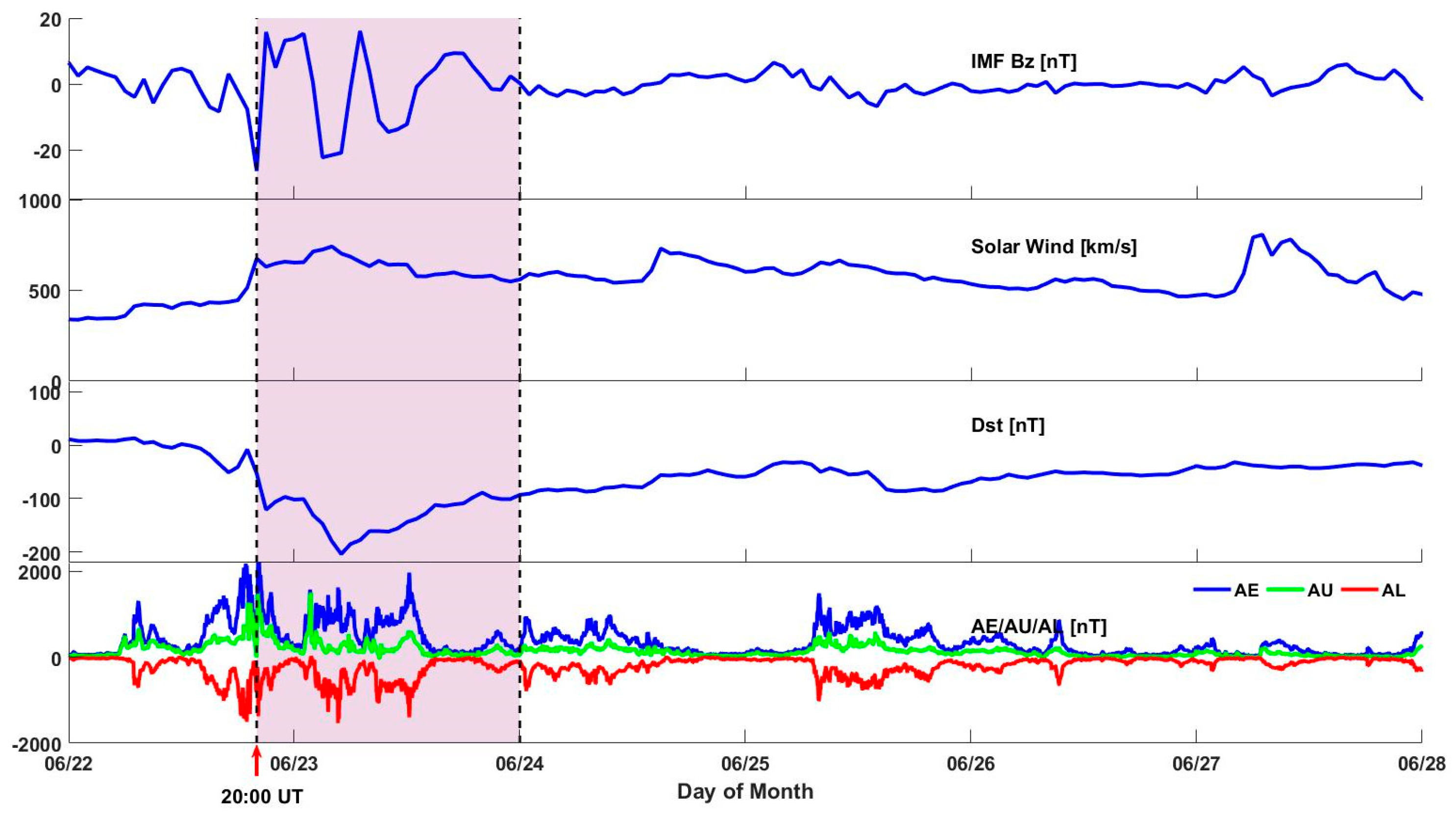

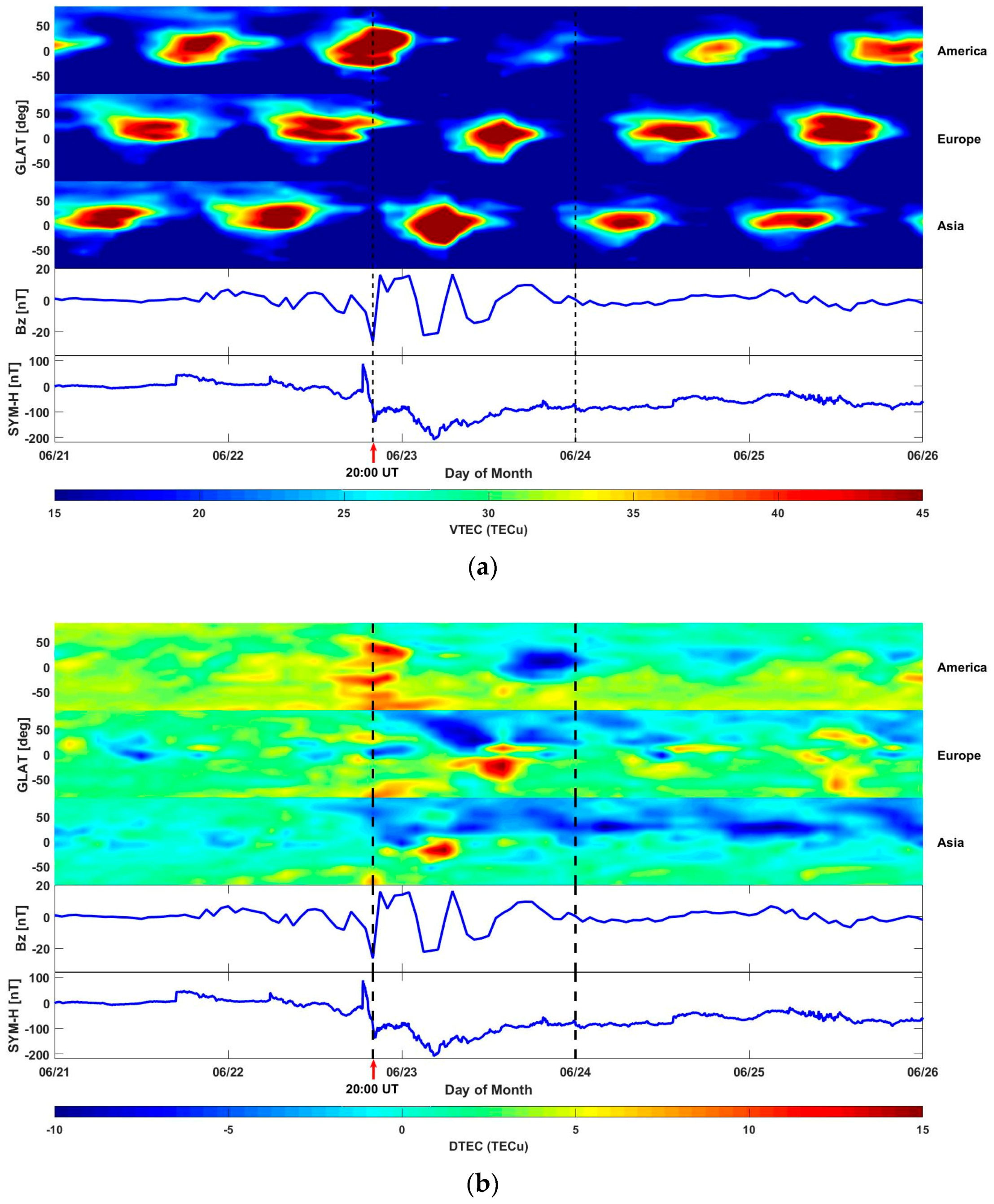
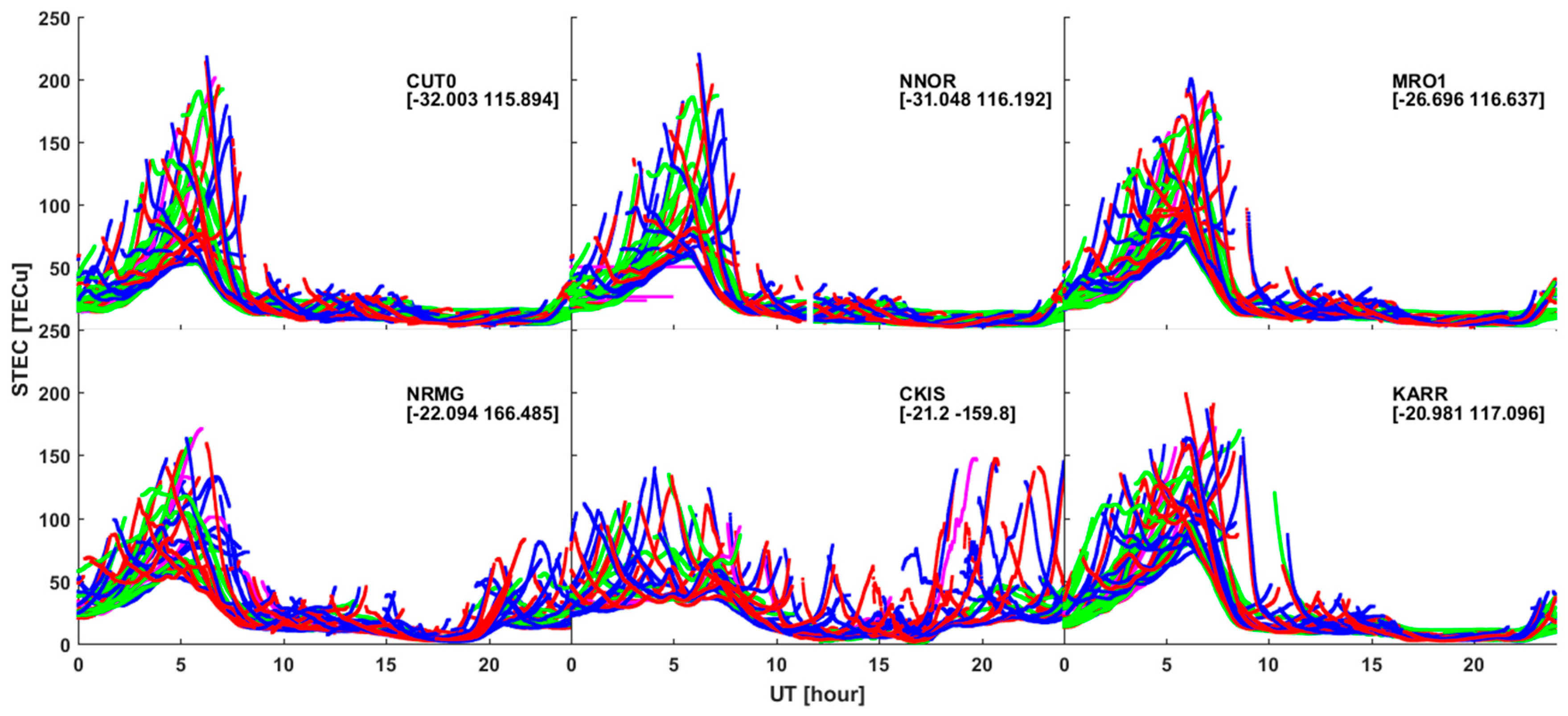
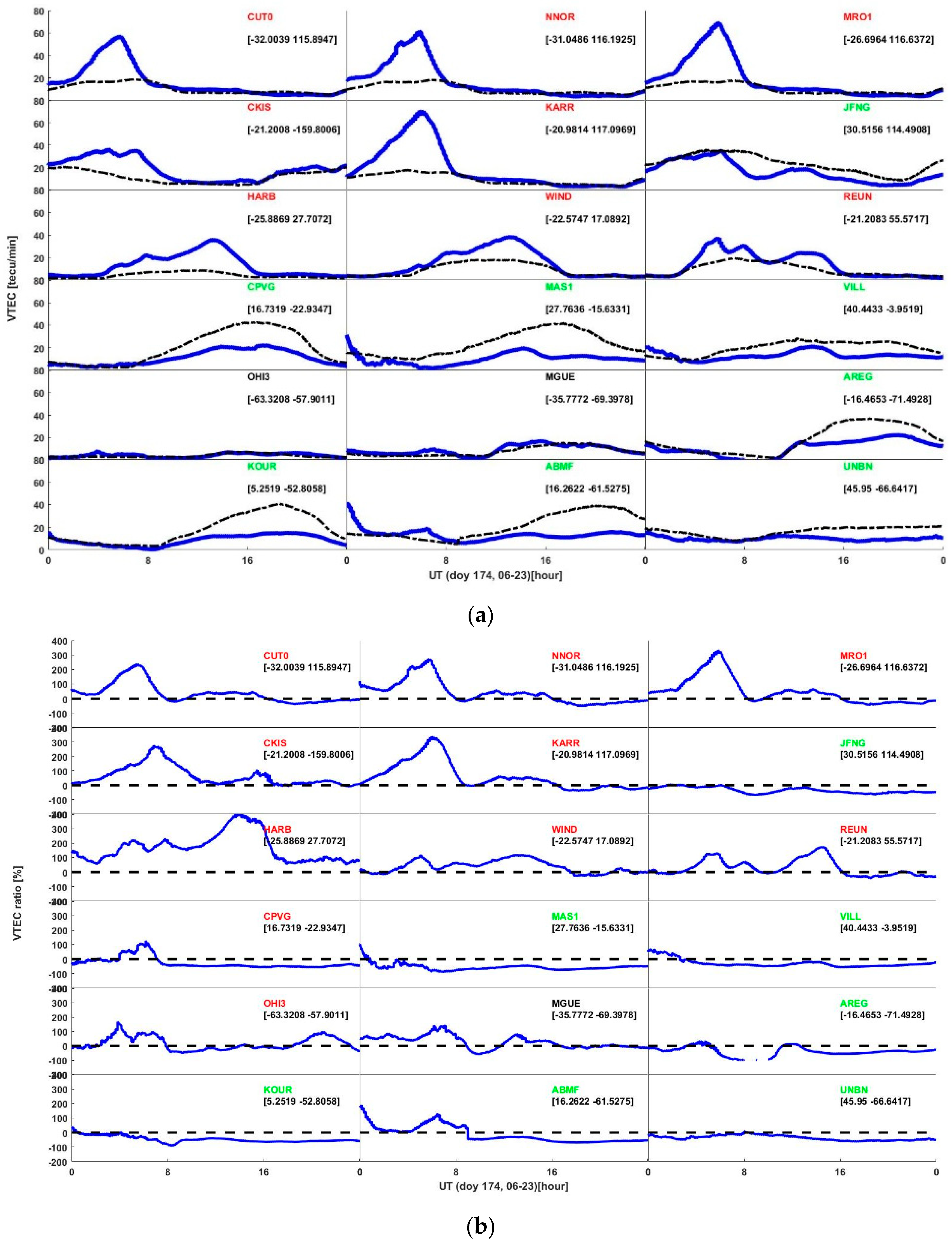
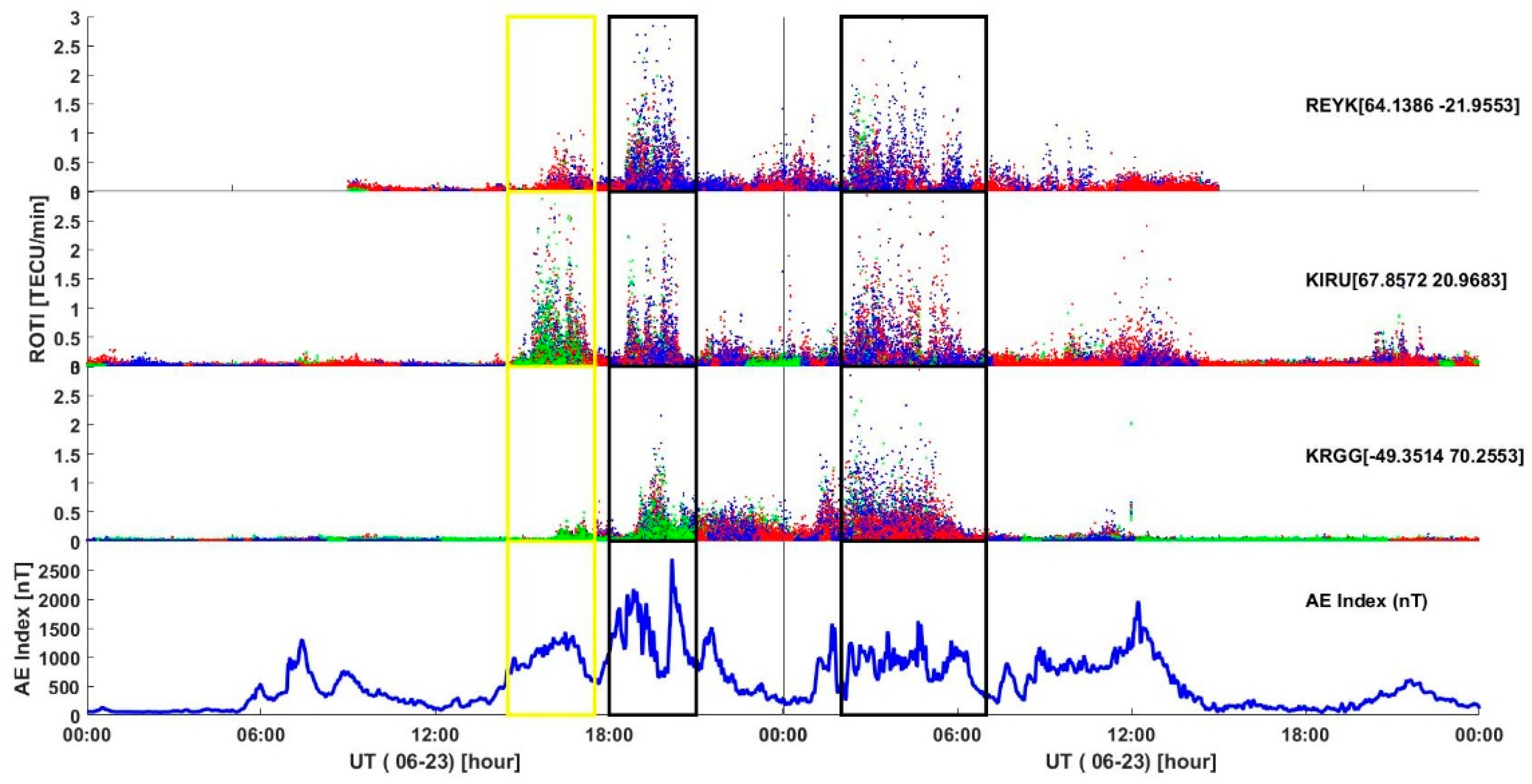
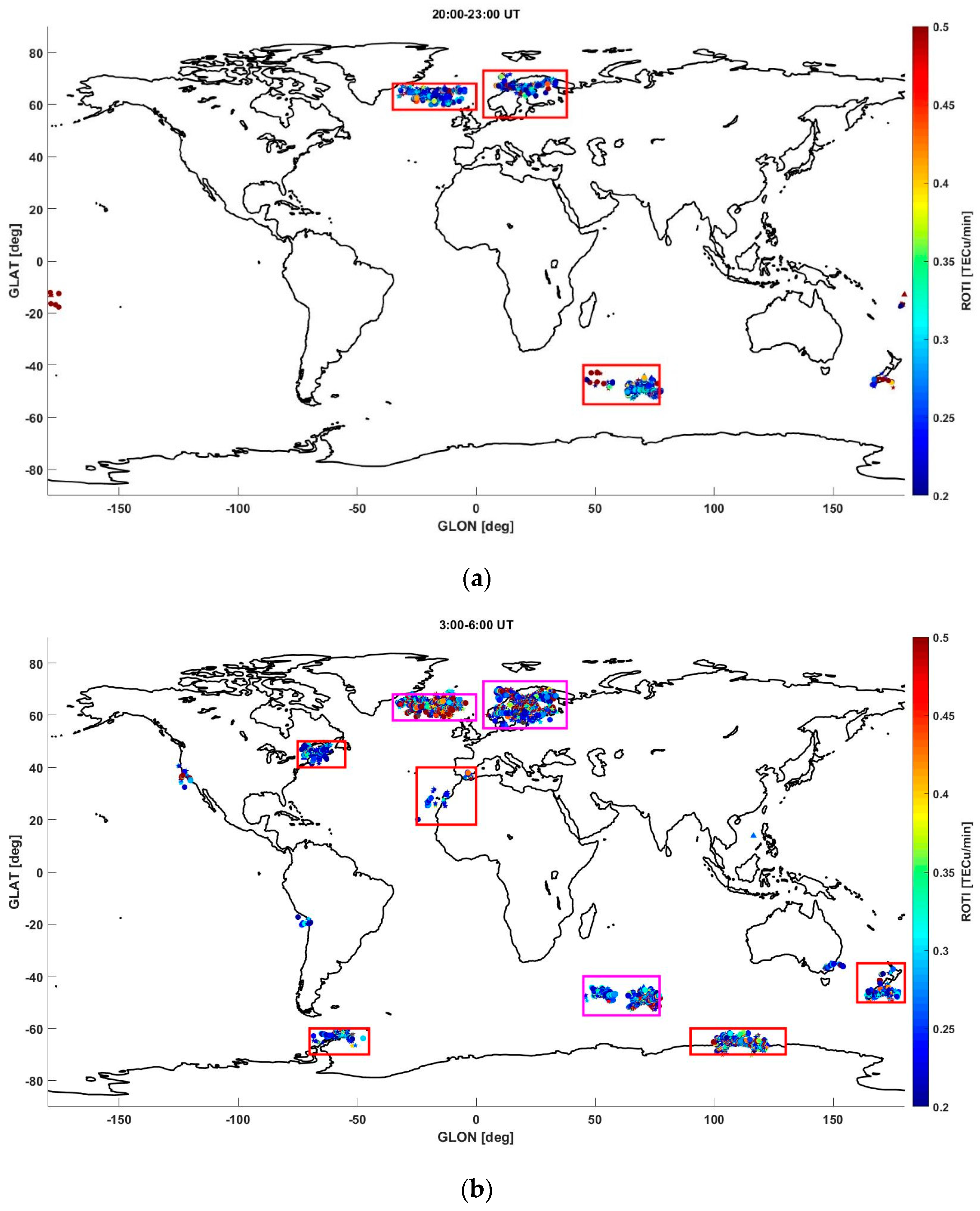

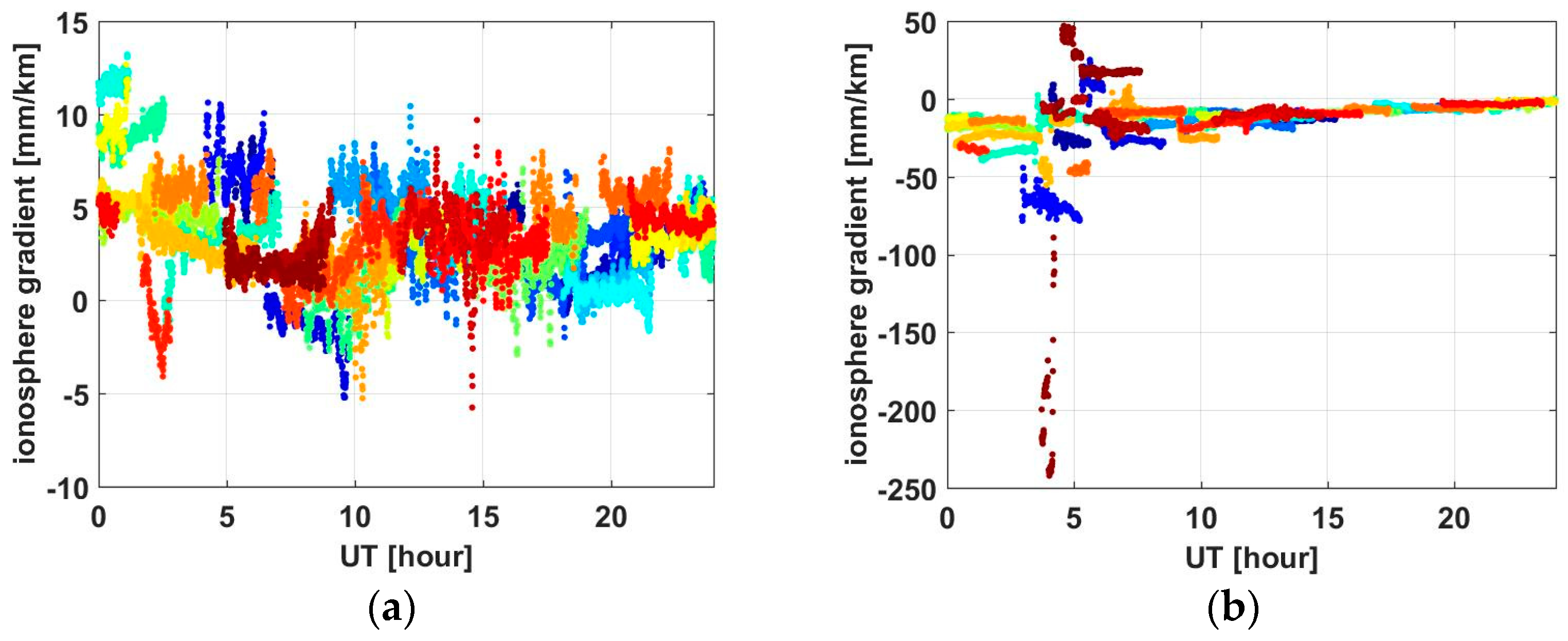
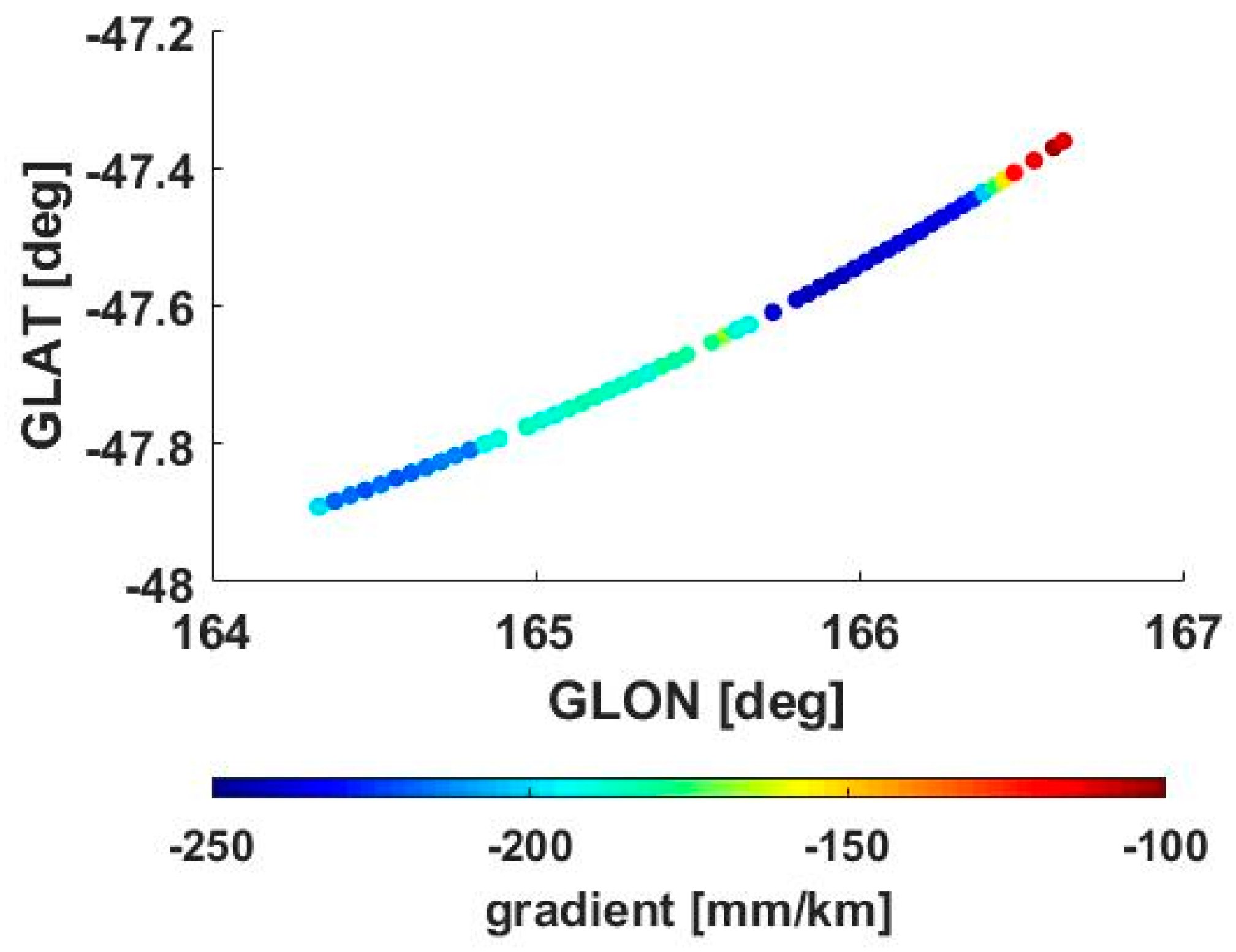

© 2018 by the authors. Licensee MDPI, Basel, Switzerland. This article is an open access article distributed under the terms and conditions of the Creative Commons Attribution (CC BY) license (http://creativecommons.org/licenses/by/4.0/).
Share and Cite
Liu, Y.; Fu, L.; Wang, J.; Zhang, C. Studying Ionosphere Responses to a Geomagnetic Storm in June 2015 with Multi-Constellation Observations. Remote Sens. 2018, 10, 666. https://doi.org/10.3390/rs10050666
Liu Y, Fu L, Wang J, Zhang C. Studying Ionosphere Responses to a Geomagnetic Storm in June 2015 with Multi-Constellation Observations. Remote Sensing. 2018; 10(5):666. https://doi.org/10.3390/rs10050666
Chicago/Turabian StyleLiu, Yang, Lianjie Fu, Jinling Wang, and Chunxi Zhang. 2018. "Studying Ionosphere Responses to a Geomagnetic Storm in June 2015 with Multi-Constellation Observations" Remote Sensing 10, no. 5: 666. https://doi.org/10.3390/rs10050666



